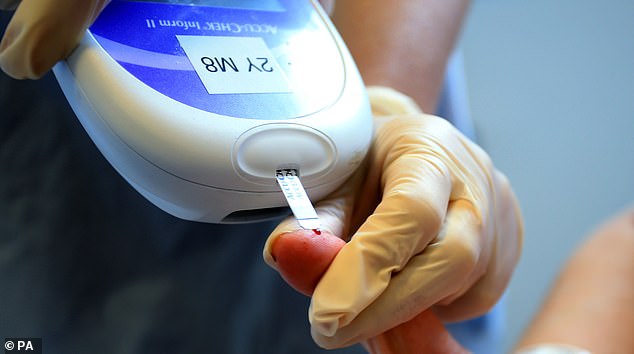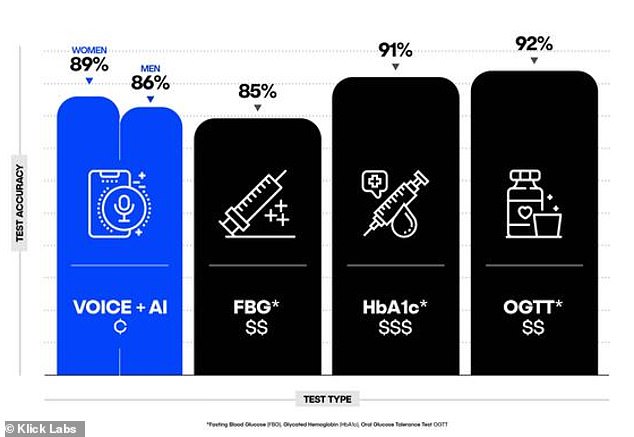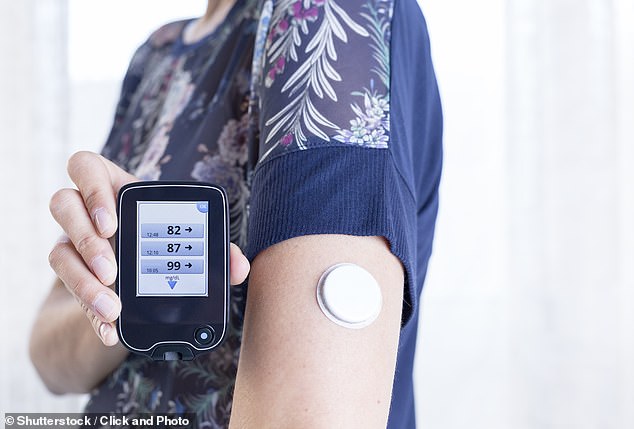AI can diagnose people with diabetes in 10 SECONDS using voice recording, new study reveals
>
Canadian medical researchers have trained a machine learning AI to accurately predict type 2 diabetes from just six to 10 seconds of a patient’s spoken voice.
This was achieved after the model identified 14 vocal characteristics for differences between non-diabetic and type 2 diabetic individuals.
The AI focused on a range of audio features, including subtle changes in pitch and sound intensity that the human ear can’t hear, for doctors, and linked that data to basic health information, including a patient’s age, gender, height and weight.
The researchers found that gender proved to be a decisive factor: AI could diagnose the disease with 89% accuracy in women, but with a slightly lower accuracy, 86% in men.

A Canadian company has trained machine learning AI to accurately predict type 2 diabetes from just six to 10 seconds of a patient’s spoken voice. AI promises to dramatically reduce costs for lay people with this chronic condition, which is traditionally experienced in person

Among the most common diabetes tests used are the glycated hemoglobin (A1C) test, the fasting blood glucose (FBG) test, and the oral glucose tolerance tests (OGTT), all of which require patients to travel to their doctor. The team hopes that artificial intelligence can remove these costly barriers
The AI model promises to significantly reduce the cost for lay people with a chronic health condition, which traditionally must be experienced in person.
Automated remote diagnosis could help millions judge from data collected by the International Diabetes Federation, which reports that nearly half of adults with diabetes, or 240 million adults, don’t know they have the condition.
“Our research highlights significant vocal differences between individuals with and without type 2 diabetes,” said Jaycee Kaufman, first author of the paper and a research scientist at Klick Labs, which plans to commercialize the program.
Kaufman hopes the company’s AI can do just thatTransforming how the medical community screens for diabetes.
In the past, expensive personal diagnostic tests, including blood testing, were needed to screen for prediabetes and type 2 diabetes.
Among the most common tests used are the glycated hemoglobin (A1C) test, the fasting blood glucose (FBG) test, and the oral glucose tolerance tests (OGTT), all of which require patients to make a physical trip to their healthcare provider.
“Current detection methods can be time, travel and cost intensive,” Kaufman noted in a statement accompanying the new study, published Tuesday in the journal Science. Mayo Clinic Proceedings: Digital Health.
“Voice technology has the potential to completely remove these barriers,” she said.
Working with faculty at Ontario Tech University in Canada, Klick Labs scientists trained the AI using recordings made by 267 people recruited from India.
Nearly 72%, a control group of 79 women and 113 men, were diagnosed as non-diabetic, while 18 women and 57 men had previously been diagnosed with type 2 diabetes.
Recruited with commitment American Diabetes Association guidelines, according to researchers at Klick Labs.
The 267 participants were asked to record a phrase on their cell phones six times a day for two weeks.
From 18,000 individual recordings, Click scientists focused on 14 vocal features looking for consistent, replicable differences between groups with and without type 2 diabetes.
Four of these audio features proved to be the most useful in accurately predicting who has diabetes and who does not.
“Pitch” and “standard deviation of pitch” were useful for both male and female patients, while a feature called “relative mean disturbance jitter” was more useful in predicting disease in women. In men, auditory features are called“Intensity” and “flashing 11 point amplitude disturbance quotient” are red flags for men.
Kaufman, of Click Labs, called the sex-based differences found through AI signal processing “surprising.”

The company’s AI became more accurate when the age and body mass index (BMI) of the person behind the audio recordings was incorporated into their prediction model, the team reported in their peer-reviewed research. They hope that future research will replicate the results of their study
The company’s AI became more accurate when the age and body mass index (BMI) of the person behind the audio recordings was incorporated into their prediction model, the team reported in their peer-reviewed research.
“Our research underscores the tremendous potential of voice technology in identifying type 2 diabetes and other health conditions,” said Jan Fossat, vice president of Klick Labs and principal investigator of the new study.
Fossat also teaches at Ontario Tech University, where he is an assistant professor in the school’s Faculty of Science, with a focus on mathematical modeling and computational science.Italian health.
the professor He said he hopes Klick’s non-intrusive and accessible AI approach, which can lead to diagnoses made via a simple phone app, will help identify and help millions of undiagnosed people quietly suffering from type 2 diabetes.
“Voice technology can revolutionize healthcare practices as an accessible and affordable digital screening tool,” Fossat added.
He said the next steps will begin with attempts to replicate the new study.
Fossat expressed hope that Klick Labs will soon be able to expand its research into voice diagnostics to include other medical areas, such as prediabetes, women’s health, and hypertension.
(Tags for translation)dailymail
